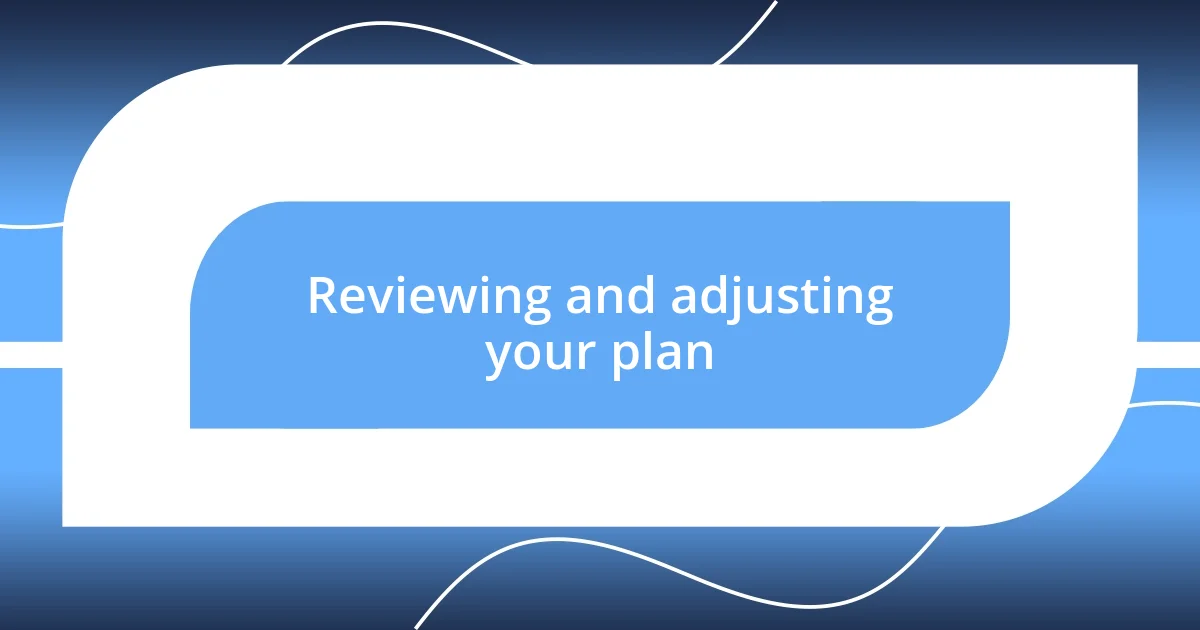Key takeaways:
- A tech detox enhances mental clarity, emotional resilience, and helps realign priorities, allowing for richer personal connections.
- Identifying personal tech triggers, such as emotional states and social influences, empowers individuals to make deliberate choices regarding their technology use.
- Establishing realistic goals, incorporating tech-free activities, and regularly reviewing one’s plan are essential for maintaining a sustainable balance with technology.

Understanding tech detox benefits
One of the most profound benefits of a tech detox is the mental clarity it often brings. I remember a weekend where I put my phone aside and focused on reading instead. It was surprising how quickly my thoughts organized themselves, and I found solutions to problems that had been clouding my mind for weeks. Isn’t it interesting how stepping away from screens can clear the static and help us think more clearly?
Taking a break from technology can also enhance our emotional resilience. When I unplugged for a few days, I instantly noticed my ability to appreciate the small joys around me—a chat with a neighbor or enjoying a meal without distractions. Have you ever felt the warmth of a moment like that? It’s these seemingly trivial experiences that allow us to reconnect with our emotions and strengthen our relationships with others.
Moreover, disconnecting gives you a chance to realign your priorities. I often found myself caught in endless scrolling, only to realize my to-do list was gathering dust. Through tech detox, I learned to focus on what truly matters, like hobbies and connections that nourish my spirit. What would happen if you set aside digital distractions for a while? You might just rediscover passions that spark your joy and creativity.

Identifying personal tech triggers
Identifying personal tech triggers is crucial for anyone looking to navigate their relationship with technology. For me, it was the incessant pings of social media notifications that drew me back to my device during moments I yearned for peace. When I paid attention, I realized that these triggers often coincided with feelings of boredom or anxiety. Recognizing these patterns helped me become more mindful, allowing me to deliberately choose activities that brought me joy instead of succumbing to the urge to check my phone.
To pinpoint your tech triggers, consider the following:
- Emotional States: Do you reach for your phone when you’re feeling anxious, bored, or lonely?
- Environmental Cues: Are there specific places or situations where tech usage spikes, such as during commutes or while waiting in line?
- Social Influences: Do you feel pressured to check your devices because of your friends or peers?
- Time of Day: Are there particular times when you’re more prone to scrolling or gaming?
- Activities: What activities do you engage in digitally that lead to prolonged usage, like binge-watching shows or playing games?
By reflecting on these elements, you can begin to map out what specifically draws you to your devices, thus empowering you to make more intentional choices about your tech use.

Creating a personalized detox plan
Creating a personalized detox plan is like crafting a tailored wardrobe—it should fit your lifestyle and needs. I once tried a generic detox suggestion that only left me feeling frustrated, as it didn’t align with my daily rhythms. Instead, I found success by assessing my habits and determining the times I felt most tethered to my devices. By allocating specific times for tech use and relaxation, I felt more in control rather than guilty about my screen time.
It’s also essential to identify which activities you must prioritize during your detox. From my own experience, I discovered that carving out time for hobbies like painting and hiking not only satisfied my need for creativity but also kept my mind engaged productively. This led me to realize the value of scheduling my detox—whether it be a weekend getaway or an evening routine that involves electronic-free activities. What if you made a list of your passions, then designed a detox plan around them? You might just find the process enjoyable and enlightening.
Additionally, consider incorporating accountability into your detox plan. When I decided to go on a tech detox, I shared my goals with friends and family. Their support not only kept me engaged but also sparked wonderful conversations about our relationships with technology. Just think—having someone to share your journey with can not only motivate you but also provide the perspective you might need when you feel tempted to revert to old habits.
| Detox Element | Description |
|---|---|
| Time Allocation | Schedule specific hours for device use and breaks. |
| Passion Projects | Engage in activities that reignite your interests. |
| Accountability | Share your detox goals with friends or family members. |

Setting realistic detox goals
Setting realistic detox goals is essential to ensure your tech detox doesn’t feel overwhelming. I remember when I first attempted a digital break; I aimed for an entire week without screens. Instead of feeling liberated, I found myself stressed and constantly thinking about my devices. It taught me that small, attainable goals can lead to sustainable change. For example, starting with a few tech-free hours each day made it easier to adjust without feeling deprived.
Have you ever thought about the power of gradual commitment? I’ve found that setting interim goals—like reducing social media use from an hour to thirty minutes—allows for a smoother transition. This approach not only makes it manageable but also gives you a sense of accomplishment as you observe your progress. Each small success builds momentum, making the overall journey less intimidating.
Moreover, adjusting your expectations can significantly influence your experience. For instance, during one of my past tech detox attempts, I ditched all screens after 6 PM. Initially, it felt jarring. But once I allowed myself to use my phone for essential calls, the guilt diminished and I started enjoying the process. Wouldn’t it be liberating to learn that flexibility in your goals can actually enhance your sense of freedom? Embracing your own unique rhythm is key in finding a balance that truly supports a healthier relationship with technology.

Implementing daily tech-free activities
Integrating daily tech-free activities into my routine has been nothing short of transformative. I started carving out mornings dedicated to journaling and meditation, which have anchored my day. Sometimes, I find myself asking, “What did I really enjoy doing before I became so dependent on my phone?” These moments of reflection foster creativity and clarity that daily scrolling never could.
I’ve also experimented with tech-free zones in my home. For instance, I designated my dining table as a no-device area. Sharing meals without distractions not only made our conversations deeper but also heightened my appreciation for the food. It’s amazing how simply removing screens allows us to reconnect with ourselves and with each other. Don’t you think we often overlook the simple joys of face-to-face interactions?
Engaging in physical activities has also made a remarkable difference in how I approach my tech detox. Last weekend, I signed up for a local hiking group—something I hadn’t done in years. The thrill of being outdoors, surrounded by nature, made me realize how much I had missed out on while glued to my screen. Have you ever noticed how a walk outside can refresh your mind? Those tech-free moments feel like breathing fresh air into my routine, allowing me to recharge without the constant pull of notifications.

Reviewing and adjusting your plan
Reflecting on my tech detox journey has often led me to surprising realizations. Just a few weeks in, I noticed I was struggling to stick to my initial plan. I felt overwhelmed and almost guilty when I occasionally slipped. But instead of giving up, I learned the importance of reviewing my approach. It became clear that adapting goals based on my experiences would transform my detox from a strict regimen to a more thoughtful practice. Have you ever felt the weight of unrealistic expectations? Sometimes, acknowledging our humanity in these processes is what leads to sustainability.
I vividly recall a moment when I realized that my original goal of limiting screen time to two hours was simply too harsh. Having just returned from a long trip, I was exhausted. On one particularly tiring day, I found myself mindlessly scrolling for more than that. Instead of feeling defeated, I adjusted my plan to incorporate a relaxing evening routine of unwinding with a book instead of my devices. Rethinking my strategy in real time helped me stay true to my objectives while also being kind to myself.
One effective technique I’ve adopted is scheduling regular check-ins with myself. I set aside time each week to assess what’s working and what needs tweaking. It might sound a bit structured, but think about it: wouldn’t it be nice to have a moment to reflect and recalibrate? During these check-ins, I often discover new distractions to eliminate or tech-free intervals that enhanced my well-being. This iterative process not only empowers me but also keeps my detox from becoming stagnant. The more I review and adjust, the more I find balance and fulfillment in my relationship with technology.

Maintaining long-term tech balance
Maintaining a long-term tech balance isn’t just about cutting back; it’s also about integrating a mindful approach into my daily life. For me, it was essential to create rituals that didn’t revolve around screens. I’ve started a weekly game night with friends, where we enjoy laughter, fun, and a few friendly competitions—no devices allowed. Have you ever experienced how shared moments like this can strengthen bonds that often get overshadowed by our individual screens?
I also find it helpful to establish tech boundaries that fit into my lifestyle. For instance, I now have a set “tech-free Sunday” where the family and I engage in activities like cooking or exploring local parks. This day has become a refuge from the digital noise that often fills my week. Isn’t it interesting how these dedicated breaks not only rejuvenate me but also spark creativity and meaningful conversations? I cherish those Sundays because they remind me of the moments where I truly connect—not just with my family but with myself.
Finally, I’ve embraced spontaneity as a tool for maintaining balance. While having set routines is valuable, I’ve found that allowing myself to occasionally go off-script can lead to delightful surprises. Last month, I spontaneously joined friends for an impromptu dance class instead of my usual Saturday binge-watch. The joy I felt moving about, trying new things, reminded me just how vital it is to embrace life outside the digital realm. Have you noticed how those unplanned moments leave lasting impressions? It’s in those experiences that we truly thrive without tech, deepening our interactions and enriching our lives in ways that mere scrolling never could.












